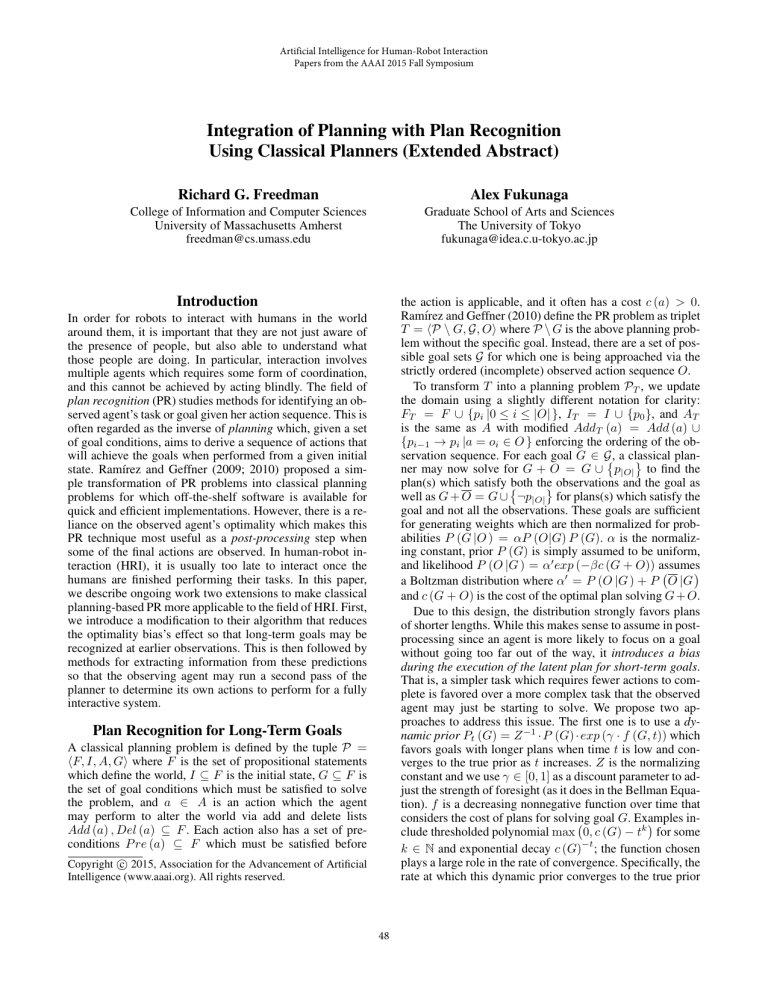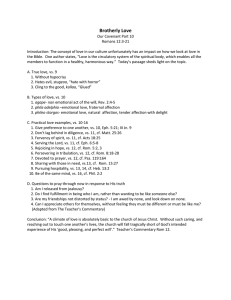
Artificial Intelligence for Human-Robot Interaction
Papers from the AAAI 2015 Fall Symposium
Integration of Planning with Plan Recognition
Using Classical Planners (Extended Abstract)
Richard G. Freedman
Alex Fukunaga
College of Information and Computer Sciences
University of Massachusetts Amherst
freedman@cs.umass.edu
Graduate School of Arts and Sciences
The University of Tokyo
fukunaga@idea.c.u-tokyo.ac.jp
Introduction
the action is applicable, and it often has a cost c (a) > 0.
Ramı́rez and Geffner (2010) define the PR problem as triplet
T = hP \ G, G, Oi where P \ G is the above planning problem without the specific goal. Instead, there are a set of possible goal sets G for which one is being approached via the
strictly ordered (incomplete) observed action sequence O.
To transform T into a planning problem PT , we update
the domain using a slightly different notation for clarity:
FT = F ∪ {pi |0 ≤ i ≤ |O| }, IT = I ∪ {p0 }, and AT
is the same as A with modified AddT (a) = Add (a) ∪
{pi−1 → pi |a = oi ∈ O } enforcing the ordering of the observation sequence. For each goal G ∈ G,
a classical planner may now solve for G + O = G ∪ p|O| to find the
plan(s) which satisfy both the observations and the goal as
well as G + O = G ∪ ¬p|O| for plans(s) which satisfy the
goal and not all the observations. These goals are sufficient
for generating weights which are then normalized for probabilities P (G |O ) = αP (O|G) P (G). α is the normalizing constant, prior P (G) is simply assumed to be uniform,
and likelihood P (O |G ) = α0 exp (−βc (G + O)) assumes
a Boltzman distribution where α0 = P (O |G ) + P O |G
and c (G + O) is the cost of the optimal plan solving G + O.
Due to this design, the distribution strongly favors plans
of shorter lengths. While this makes sense to assume in postprocessing since an agent is more likely to focus on a goal
without going too far out of the way, it introduces a bias
during the execution of the latent plan for short-term goals.
That is, a simpler task which requires fewer actions to complete is favored over a more complex task that the observed
agent may just be starting to solve. We propose two approaches to address this issue. The first one is to use a dynamic prior Pt (G) = Z −1 · P (G) · exp (γ · f (G, t)) which
favors goals with longer plans when time t is low and converges to the true prior as t increases. Z is the normalizing
constant and we use γ ∈ [0, 1] as a discount parameter to adjust the strength of foresight (as it does in the Bellman Equation). f is a decreasing nonnegative function over time that
considers the cost of plans for solving goal G. Examples
in
clude thresholded polynomial max 0, c (G) − tk for some
−t
k ∈ N and exponential decay c (G) ; the function chosen
plays a large role in the rate of convergence. Specifically, the
rate at which this dynamic prior converges to the true prior
In order for robots to interact with humans in the world
around them, it is important that they are not just aware of
the presence of people, but also able to understand what
those people are doing. In particular, interaction involves
multiple agents which requires some form of coordination,
and this cannot be achieved by acting blindly. The field of
plan recognition (PR) studies methods for identifying an observed agent’s task or goal given her action sequence. This is
often regarded as the inverse of planning which, given a set
of goal conditions, aims to derive a sequence of actions that
will achieve the goals when performed from a given initial
state. Ramı́rez and Geffner (2009; 2010) proposed a simple transformation of PR problems into classical planning
problems for which off-the-shelf software is available for
quick and efficient implementations. However, there is a reliance on the observed agent’s optimality which makes this
PR technique most useful as a post-processing step when
some of the final actions are observed. In human-robot interaction (HRI), it is usually too late to interact once the
humans are finished performing their tasks. In this paper,
we describe ongoing work two extensions to make classical
planning-based PR more applicable to the field of HRI. First,
we introduce a modification to their algorithm that reduces
the optimality bias’s effect so that long-term goals may be
recognized at earlier observations. This is then followed by
methods for extracting information from these predictions
so that the observing agent may run a second pass of the
planner to determine its own actions to perform for a fully
interactive system.
Plan Recognition for Long-Term Goals
A classical planning problem is defined by the tuple P =
hF, I, A, Gi where F is the set of propositional statements
which define the world, I ⊆ F is the initial state, G ⊆ F is
the set of goal conditions which must be satisfied to solve
the problem, and a ∈ A is an action which the agent
may perform to alter the world via add and delete lists
Add (a) , Del (a) ⊆ F . Each action also has a set of preconditions P re (a) ⊆ F which must be satisfied before
Copyright c 2015, Association for the Advancement of Artificial
Intelligence (www.aaai.org). All rights reserved.
48
may be derived from the derivative of the KL-Divergence:
X df (G, t)
dDKL (P ||Pt )
=γ
(Pt (G) − P (G))
dt
dt
Algorithm 1: Permutations of a Partially Ordered Plan
2
permutations(Node f rom = SOURCE, Node to = SINK)
if f rom == to or |f rom.children| == 0 then
return 1
. Base Case
3
else
1
G∈G
This rate resembles an error-correcting feedback loop with
step-size γ. In the case that an observed agent actually does
favor performing simpler tasks with more short-term goals,
we hypothesize that actually updating the Bayesian prior
will eventually make the true prior large enough to counter
the effect of the dynamic prior in favor of simpler goals.
The second method to consider is adjusting the likelihood to consider the number of optimal plans P (O |G ) =
α0 # (G + O) exp (−βc (G + O)). Ramı́rez and Geffner
(2010) acknowledge ignoring this value even though it could
have an impact on the distribution since the number of permutations of a partially ordered plan can yield more options for completing a task. The Boltzman distribution is still
maintained since the count is a scalar multiple which may be
written as a power of e. Algorithm 1 provides a method for
counting the number of executable plans given a partially ordered plan in the form of a directed acyclic graph with causal
edges indicating actions whose effects satisfy other actions’
preconditions; the source is the initial state and the sink is
the goal. This may be viewed as a compressed form of the
planning graph (Blum and Furst 1997).
To avoid lag during runtime, we note that the algorithm
may be run a priori for all G ∈ G regardless of O. As long
as O is a subsequence of the optimal partial plan for some
G, then we can find # (G + O) and # G + O from the
precomputations without needing to run the planner again
since the optimal plan does not change. Even if O is not a
subsequence of an optimal plan, then we only need to run the
planner and Algorithm 1 for goal G + O since the optimal
plan for G + O (and thus # G + O ) is precomputed.
X = BFS(f rom, f rom.children ∈ X.ancestors)
. Each child’s branch rejoins at node X
totalN odes = 0
for each Node c ∈ f rom.children do
nodesT oXf rom[c] = nodesBetween(c, X)
totalN odes+ = nodesT oXf rom[c]
4
5
6
7
8
14
perm = permutations(X, to)
. Count from rejoin
for each Node c ∈ f rom.children
do
totalN odes
perm∗ = nodesT
∗ permutations(c, X)
oXf rom[c]
totalN odes− = nodesT oXf rom[c]
return totalN odes
nodesBetween(Node f rom, Node to)
if to ∈ f rom.children then
return 1
15
else
9
10
11
12
13
16
return 1 +
P
c∈f rom.children
nodesBetween(c, to)
optimistic since the human is acting independently and is not
guaranteed to follow the joint plan. This introduces the need
for replanning with new observations throughout the interaction; we leave identifying when to replan as future work.
To avoid replanning in mid-execution, we can also generate local intermediate plans using landmarks (Hoffmann,
Porteous, and Sebastia 2004) for the most likely goal(s).
This is similar to work by Levine and Williams (2014) where
a robot recognizes local human activity at branching points
in predefined plans and then executes its own plan so that
later actions in the predefined plan may be performed. However, landmarks may be computed efficiently for any arbitrary plan (Keyder, Richter, and Helmert 2010) and do not
have to be restricted to branching points. We can also perform local PR using these landmarks in place of G and then
use the necessity of propositions over landmarks to derive
GR . While it seems better to just use landmarks with the
initial PR process in lieu of all the proposed modifications,
we note that many long-term plans have multiple parts that
may be done in parallel so that the robot can drastically reduce the time to perform the entire task.
Deriving an Interactive Response
Following the probabilistic PR process modified above,
the observing robot may plan its own behaviors with
respect to its predictions of the human’s plans. Given
its own set of actions AR and current state IO based
on the observed actions, we may define its planning
problem as a centralized multiagent system PR =
hF, IO , A ∪ {no-op} × AR ∪ {no-op} , GR i where GR is
derived from the goal probabilities and robot’s purpose. We
define the necessity of a P
proposition with respect to the set
of goals as N (p ∈ F ) = G∈G P (G |O )·1 (p ∈ G) where
1 is the indicator function. A necessity of 1 implies that all
goals with probability > 0 require p as a condition and 0 implies that no predicted goals require p as a condition. Then
for some threshold T , we define three cases for GR :
Assistive GR = {p |N (p) ≥ T }
Adversarial GR = {¬p |N (p) ≥ T }
Independent GR = {p |N (p) ≥ T } ∪ G0 where G0 is a
distinct task assigned to the robot
For each case, the robot may use the same off-the-shelf classical planner from the PR step to derive the joint plan it
should perform alongside the human. However, this plan is
Future Work
Besides implementing and evaluating the methods proposed
above, there are further directions in which this work may
be extended. In particular, many real-world problems which
use robots such as search and rescue (Jung, Takahashi, and
Grupen 2014) rely on sensor data observations which do
not provide the high-level action representations needed for
classical planners. Freedman, Jung, and Zilberstein (2014)
begins to address this issue by identifying clusters of sensor
readings which may resemble actions, but connecting them
to planners will be necessary to have interaction in practical domains. For specialized domains where we can repre-
49
sent the observations at this higher level, there appears to be
an opportunity to use these together for specific domains of
HRI.
References
Blum, A. L., and Furst, M. L. 1997. Fast planning through
planning graph analysis. Journal of Artificial Intelligence
90(1-2):281–300.
Freedman, R. G.; Jung, H.-T.; and Zilberstein, S. 2014. Plan
and activity recognition from a topic modeling perspective.
In Proc. of the 24th Int’l Conference on Automated Planning
and Scheduling, 360–364.
Hoffmann, J.; Porteous, J.; and Sebastia, L. 2004. Ordered
landmarks in planning. Journal of Artificial Intelligence Research 22(1):215–278.
Jung, H.-T.; Takahashi, T.; and Grupen, R. A. 2014. Humanrobot emergency response - experimental platform and preliminary dataset. Technical report, University of Massachusetts Amherst.
Keren, S.; Gal, A.; and Karpas, E. 2014. Goal recognition
design. In Proceedings of the Twenty-Fourth International
Conference on Automated Planning and Scheduling, ICAPS
2014, Portsmouth, New Hampshire, USA, June 21-26, 2014.
Keren, S.; Gal, A.; and Karpas, E. 2015. Goal recognition design for non-optimal agents. In Proceedings of the
Twenty-Ninth Conference on Artificial Intelligence, 3298–
3304.
Keyder, E.; Richter, S.; and Helmert, M. 2010. Sound and
complete landmarks for and/or graphs. In Proceedings of the
Nineteenth European Conference on Artificial Intelligence,
335–340. IOS Press.
Levine, S. J., and Williams, B. C. 2014. Concurrent plan
recognition and execution for human-robot teams. In Proceedings of the Twenty-Fourth Interntional Conference on
Automated Planning and Scheduling, 490–498.
Ramı́rez, M., and Geffner, H. 2009. Plan recognition as
planning. In Proceedings of the 21st International Joint
Conference on Artificial Intelligence, 1778–1783.
Ramı́rez, M., and Geffner, H. 2010. Probabilistic plan recognition using off-the-shelf classical planners. In Proceedings
of the Twenty-Fourth AAAI Conference on Artificial Intelligence.
50










